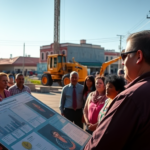Harlingen Embarks on Major Drainage System Upgrades
As part of a strategic initiative to combat persistent flooding issues, Harlingen city officials announced a two-million-dollar investment in upgrading the city’s aging drainage infrastructure. This long-awaited project aims to address the inadequacies of existing drainage systems in Harlingen, particularly in older sections of the city that have struggled to manage heavy rainfall effectively.
An Overview of the Planned Upgrades
The forthcoming upgrades focus on strategically significant areas, including Fair Park Boulevard and downtown sectors, which have been recurrently affected by flooding. Luis Vargas, the City Engineer for Harlingen, emphasized the importance of these improvements: “Many of our current systems were not built to withstand the volume of water we’ve been experiencing. With this project, we intend to increase the capacity of existing systems and construct new stormwater technologies to better serve our community.”
Some of the highlights of the project include the widening of current drainage canals and the installation of modern stormwater management systems, specifically designed to handle the region’s intense seasonal rains. Streets like 5th and 7th, alongside Polk Avenue and Commerce Street, are earmarked for significant upgrades, promising an enhanced water flow that reduces surface runoff and street flooding.
Importance for the Rio Grande Valley
For the Rio Grande Valley (RGV), where Harlingen is located, these drainage upgrades have far-reaching implications. Frequent flooding not only disrupts daily life but also poses considerable risks to property and safety. With predictions of stray showers and temperatures in the 90s for June 1, 2025, Valley residents are reminded of the consistent need for reliable weather-responsive infrastructure.
Community member Carr Grienier, whose neighborhood close to Fair Park Boulevard has been prone to flooding, expressed both relief and anticipation. “I said ‘oh no, not again’ when I saw rain on the forecast. It’s a constant worry, but these projects give us hope for lasting changes,” Grienier remarked.
The upgrades are also timely, aligning with broader regional preparations for the hurricane season—a time when the Valley’s weather patterns can lead to more severe conditions. A conference led by local leaders in nearby cities highlighted the necessity of infrastructure improvements like Harlingen’s as part of comprehensive hurricane preparedness strategies.
Link to Broader RGV Events
The significance of Harlingen’s drainage upgrade is underscored by the recent weather challenges experienced across the Valley, from road safety accidents caused by heavy rains to concerns over emergency readiness witnessed in local conferences. With a two-vehicle crash near La Homa injuring 13 people recently, there’s a renewed focus on the infrastructures’ capacity to handle adverse weather conditions safely and efficiently.
Moreover, the construction commencing in Harlingen may offer insights and lessons for other municipalities in the RGV seeking to enhance their infrastructure resilience. As the drainage upgrades get underway, they are being closely monitored by regional leaders as a potential model for managing water-related challenges specific to South Texas.
Looking Ahead: Future Implications and Community Involvement
As construction begins, completion is anticipated by September, just in time for the peak of the hurricane season. Such preparedness positions Harlingen to better protect its residents, reducing emergency response costs and potential damage to properties.
Nevertheless, for the project to be truly successful, ongoing community engagement and awareness are crucial. Officials urge residents to remain informed via local resources, such as the KRGV FIRST WARN 5 Weather app, which provides timely updates on weather conditions and construction progress.
Additionally, as the city plans to finalize its updated master drainage plan, continued communication from city halls to doorsteps will help ensure community support and adaptation. The investment in drainage infrastructure signals a positive step for Harlingen—a step that many hope marks the beginning of more holistic improvements to support the growth and safety of the entire Rio Grande Valley.
Residents interested in learning more about the drainage project can contact the Harlingen Public Works Department or attend one of the upcoming town hall meetings dedicated to infrastructure improvements. Keeping the lines of communication open is vital for continued progress and community satisfaction.
In summary, the drainage system upgrades in Harlingen are more than a necessary technical adaptation; they represent the city’s proactive commitment to safeguarding Valley residents against weather-related challenges and fostering long-term sustainability. As construction commences, the updates are poised to bring both immediate and future benefits to the community, underscoring the importance of investing in resilient city planning and infrastructure.







